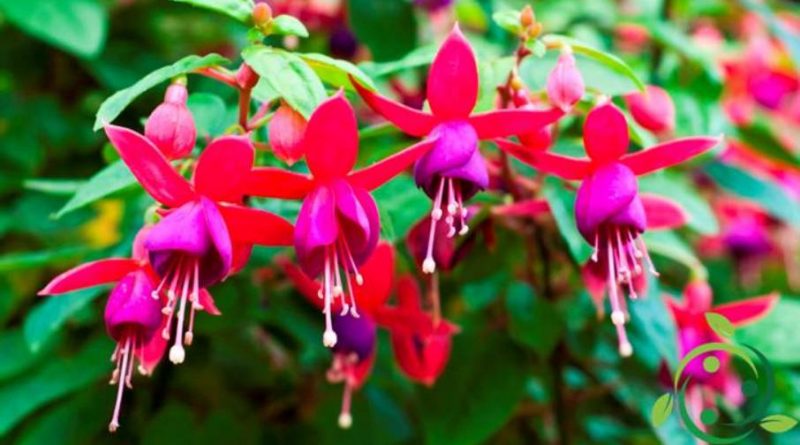How to cultivate Fuchsia
How to cultivate Fuchsia
Fuchsia is a plant of the genus Fuchsia that belongs to the Onagraceae family and has about a hundred species; these are shrubs originating in central-southern America or, more rarely, New Zealand.
They are plants that prefer a mountain habitat (forest) and have flowers with a characteristic color tone with tubular and elongated corollas. The generic term Fuchsia was given in memory of the German botanist Leonhart Fuchs (1501-1566) to whom, however, remained unknown; in fact these plants were discovered only in 1696-97 by the missionary and botanist Charles Plumier (1646-1704), who dedicated them to the German scientist to whom he bestowed great admiration.
However, we must get to the nineteenth century to begin to see this genus cultivated as ornamental plants, both in pots and, in suitable habitats, in the open ground. Plants that are commonly cultivated are hybrids between species or between cultivars.
The species belonging to the Genus are distributed in ten Sections: Ellobium, Encliandra, Fuchsia, Hemsleyella, Jimenezia, Kierschlegeria, Pachyrrihiza, Quelusia, Schufia and Skinnera.
In this card we will however see how to grow Fuchsia following the most useful agronomic tricks.
Fuchsias are deciduous shrubs with hanging branches and bottle-green leaves.
The hanging habit of some species makes them ideal for balconies, where they are cultivated in pots as single specimens or in hanging baskets.
As far as the cultivation environment is concerned, we remind that fuchsia is a plant that lives well in cool positions, in a luminous middle shade and, therefore, sheltered from the direct rays of the sun. It is a species that does not like intense heat and dry wind; sirocco winds can even be lethal to the plant.
It is a plant that for this reason prefers moist environments but not water stagnation conditions; it is advisable to keep the substratum very fresh but in conditions of excellent drainage.
Fuchsia grows well in acid, peaty, fertile, non-calcareous soils. The water you must use for irrigation must not be calcareous and, in this case, must be decalcified and must be supplied before the substrate dries.
As for the fertilization of the plant, this should be done from June to September, with fertilizer, of the liquid type for acidophilus species. If you decide to cultivate it in pots, remember that Fuchsia grows best in large pots, at least 20 -30 cm in diameter, preferably of terracotta, and in hanging baskets, as long as there is the certainty of being able to water them regularly.
If the plant is grown in colder climates, it survives well from one year to the next if you have the foresight to re-enter the pots in a cold greenhouse, otherwise it must be treated as a seasonal plant because it does not tolerate frost.
To cultivate it in pots, in general, being a plant suitable for cool areas or sunny locations: especially in the South, it is advisable to place it in balconies facing north, north-east or north-west. In any case it is always to be avoided, especially from May to September, the midday sun rays. Furthermore, the plant is poorly indicated in coastal areas subjected to twenty salts or in areas under the sirocco wind or, in any case, warm winds.
Once cultivated in pots it is necessary every two years, when young, and every 3-4 as an adult, to carry out the repotting using vessels of greater capacity each time. In addition, the substrate must always be slightly acid, peaty, fertile, moist and well drained; remember that this plant does not tolerate calcareous substrates. Repotting is carried out in March, using a peaty soil and multiplied by branch cuttings between May and August.
Irrigation water, as mentioned, must be decalcified, abundant and regular from May to September, less in the period between March-April and October, nothing in winter.
For potting fertilization it is recommended to do it from May to September, every 15 days, with liquid fertilizers for acidophilic plants; the fertilizer must be added directly to the irrigation water.
As far as pruning is concerned, this should be done at the time of winter shelter by shortening the bulky branches by a third.
Fuchsia is a plant suitable to be placed on small pillars, balusters, stairs or another place where the branches can assume their falling position.
Among the phytosanitary problems, Fuchsia can be subject to gray mold, which develops in damp and sultry environments (typical situation in greenhouses, especially at the end of winter); in this case it is advisable to move the plant in a less humid and more airy area and also not to water on the foliage.
Even the rusts that hit the leaves with reddish spots can affect the plant.
Both against molds and rusts, to avoid them, one must avoid excessive humidity or humid heat and, if they occur, treat the plant with antifungal products.
It can also be attacked by the white fly or even by aphids and scale insects especially during the first warm season; in this case you can treat homemade products based on Marseille soap.

